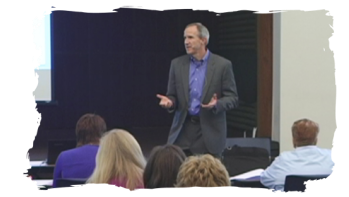
If you're planning a speech, it's always good to know what kind of presentation will be most effective for the occasion. If you've ever delivered the wrong type of message at an event, you'll know how important this is.
Generally speaking, there are three main categories of speeches: the informative speech, the persuasive speech and the entertaining speech. Let's look at the differences and how you can prepare for each type.
INFORMATIVE SPEECH
An informative speech is meant to convey information. Informative speeches can explain a process, an idea or theory or a current news event. They can be a step-by-step lecture or present a chronology of events.
Your approach is straight forward: Gather facts and statistics. Sprinkle in some examples that illustrate what those facts and statistics mean. Explain how it all comes together to help the audience better understand the topic.
Informative speeches need not be dull and boring. In fact, they better not be or the audience will tune out and miss the important information you want to convey. One way to keep things interesting is to use stories to help bring the data to life. Stories help audiences not only pay attention but actually absorb the information you're giving them.
Generally speaking, there are three main categories of speeches: the informative speech, the persuasive speech and the entertaining speech. Let's look at the differences and how you can prepare for each type.
INFORMATIVE SPEECH
An informative speech is meant to convey information. Informative speeches can explain a process, an idea or theory or a current news event. They can be a step-by-step lecture or present a chronology of events.
Your approach is straight forward: Gather facts and statistics. Sprinkle in some examples that illustrate what those facts and statistics mean. Explain how it all comes together to help the audience better understand the topic.
Informative speeches need not be dull and boring. In fact, they better not be or the audience will tune out and miss the important information you want to convey. One way to keep things interesting is to use stories to help bring the data to life. Stories help audiences not only pay attention but actually absorb the information you're giving them.
PERSUASIVE SPEECH
A persuasive speech has a specific outcome in mind for the audience. You want them to be convinced of something or moved to take action. What is it?
Persuasive speeches are usually either logical or emotional. The speaker either wants to reason with the audience or use emotion to make his case.
A logical speech uses supportive statistics and research. A logical talk to persuade someone to give up smoking would use the latest in medical data. An emotional appeal tries to tug at the audiences' heartstrings. An emotional talk to persuade someone to give up smoking might focus on the loss of a loved one to lung cancer.
The goal is to get the audience angry, inspired or frustrated with the status quo. We are often convinced more by how we feel than plain logic. Your approach is to build your speech using stories that help persuade. Come up with key phrases and memorable lines that can help underscore your argument.
Both a logical and an emotional approach are effective, though either may be more appropriate on certain occasions. A speech at a fundraiser for a youth home would likely be more emotional while a speech at a fundraiser for a politician may be more logical.
ENTERTAINING SPEECH
An entertaining speech is often a keynote at a dinner or luncheon. The purpose is not to inform or teach, although that may occur. The main purpose is to help people enjoy the moment and to help make it a successful event.
As such, the emphasis is on humor and the pacing is quicker than during an informative speech. People aren't really interested in learning as much as they are having a good time.
While entertainment is the main purpose of this speech, you may still want the audience to learn something. So, unless it's a stand-up routine with no purpose other than to produce laughs, you will want to have a direction and structure for your talk.
Your approach is to take a lighthearted view of life, yourself, the event or the group that's meeting and engage the audience with stories and illustrations that they can appreciate. It doesn't have to be a laugh a minute, but it should generally be positive and upbeat.
WHAT'S THE GOAL?
In summary, all three speeches have their place. Some speeches can be and probably should be a combination of all three aspects, depending on the circumstances of the event. Once you know the setting and the goal of the event, you can determine which type of speech will work best for you.
wesbleed.com | Twitter: @wesbleed
A persuasive speech has a specific outcome in mind for the audience. You want them to be convinced of something or moved to take action. What is it?
Persuasive speeches are usually either logical or emotional. The speaker either wants to reason with the audience or use emotion to make his case.
A logical speech uses supportive statistics and research. A logical talk to persuade someone to give up smoking would use the latest in medical data. An emotional appeal tries to tug at the audiences' heartstrings. An emotional talk to persuade someone to give up smoking might focus on the loss of a loved one to lung cancer.
The goal is to get the audience angry, inspired or frustrated with the status quo. We are often convinced more by how we feel than plain logic. Your approach is to build your speech using stories that help persuade. Come up with key phrases and memorable lines that can help underscore your argument.
Both a logical and an emotional approach are effective, though either may be more appropriate on certain occasions. A speech at a fundraiser for a youth home would likely be more emotional while a speech at a fundraiser for a politician may be more logical.
ENTERTAINING SPEECH
An entertaining speech is often a keynote at a dinner or luncheon. The purpose is not to inform or teach, although that may occur. The main purpose is to help people enjoy the moment and to help make it a successful event.
As such, the emphasis is on humor and the pacing is quicker than during an informative speech. People aren't really interested in learning as much as they are having a good time.
While entertainment is the main purpose of this speech, you may still want the audience to learn something. So, unless it's a stand-up routine with no purpose other than to produce laughs, you will want to have a direction and structure for your talk.
Your approach is to take a lighthearted view of life, yourself, the event or the group that's meeting and engage the audience with stories and illustrations that they can appreciate. It doesn't have to be a laugh a minute, but it should generally be positive and upbeat.
WHAT'S THE GOAL?
In summary, all three speeches have their place. Some speeches can be and probably should be a combination of all three aspects, depending on the circumstances of the event. Once you know the setting and the goal of the event, you can determine which type of speech will work best for you.
wesbleed.com | Twitter: @wesbleed


 RSS Feed
RSS Feed
